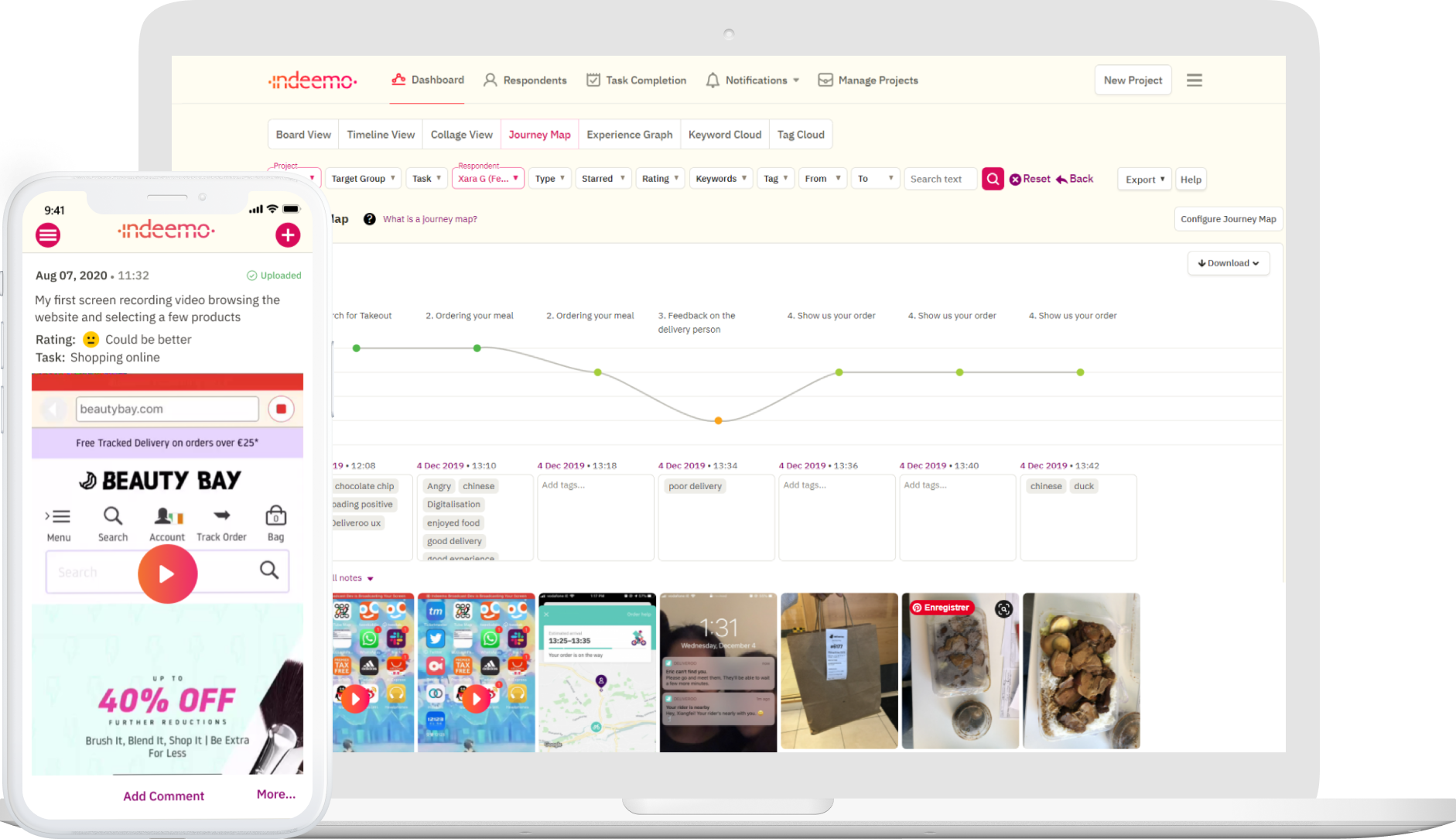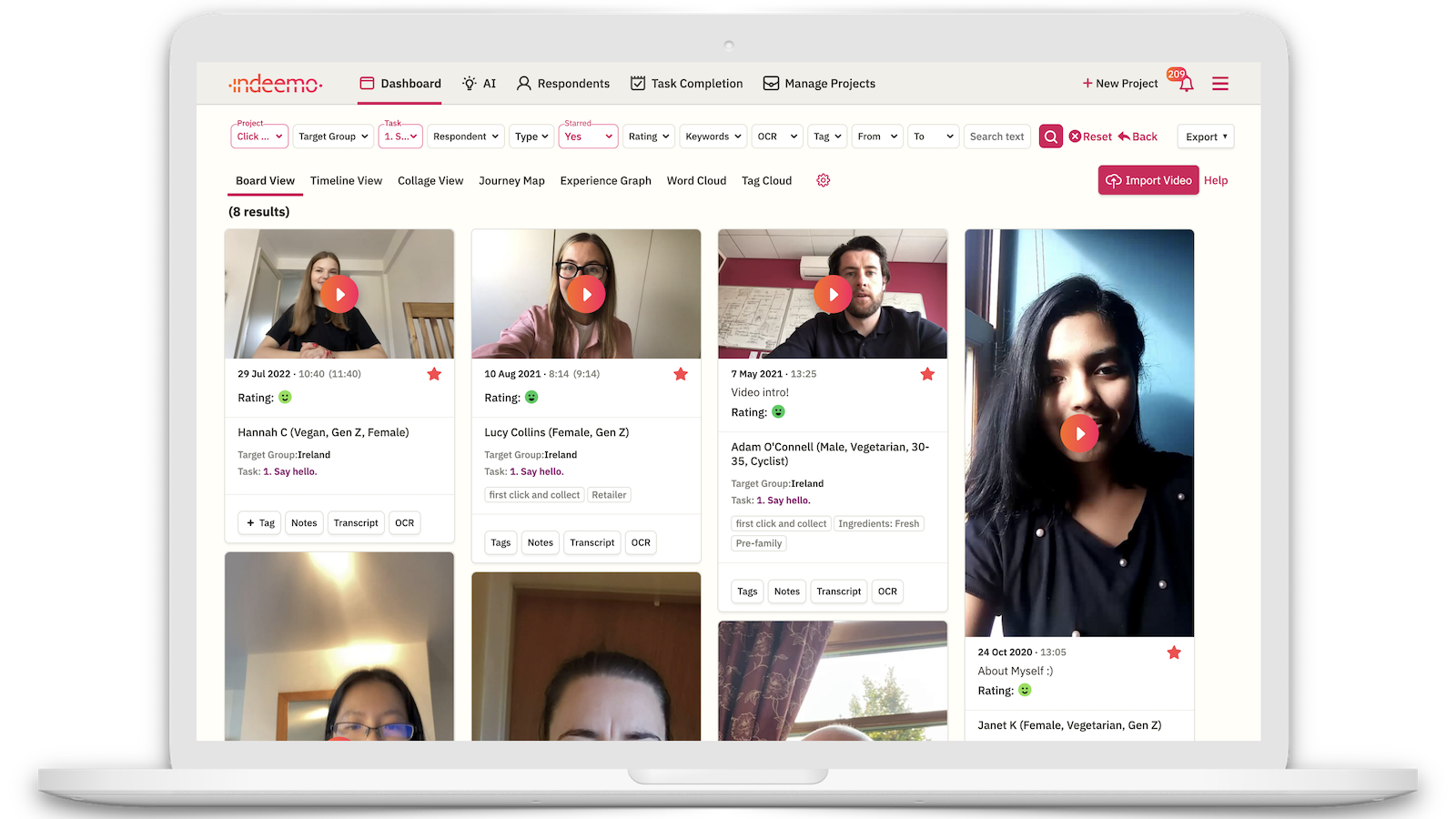We find user journey mapping becoming a novel technique that more of our clients are adopting. Yet, there is often confusion about the ins and outs of user journey mapping. We have put this guide together to help you and your team to better understand what it is and how to conduct research to best capture the user experience through journey mapping.
What is User Journey Mapping?
User Journey Mapping is the process and research agenda of documenting the user journey with a brand, product, or service. This results in the User Journey Map, which depicts each touch point the user interacts with throughout their journey.
Sometimes a User Journey Map is developed from data and insights previously compiled by marketing teams or research operations teams. Reliance on historical user experience data can often overlook changes in behaviours, personas, and touchpoints of the journey.
In recent years, decision makers and insights teams are increasingly looking for innovative ways to capture the true experiences and behaviours of their customers. User Journey Mapping is now seen as a solution and valuable formula to documenting the user experience in the moment and within context.
User research conducted during the discovery phase of product or service design is complimented by implementing journey mapping. And of course, UX design leverages on the insights derived from the user journey map.
The aim of user journey mapping is to encapsulate the true interactions between a user and the product or service. Although user journey mapping and customer journey mapping are terms that are used interchangeably, it must be noted that there are slight differences.
The concept of user journey mapping relates to the digital experiences your users encounter with your brand. This includes the online interactions with your website and the user experience with your mobile app. When we help clients build a strategy for their user journey mapping research, we encourage them to be agile, innovative, and user-centric. In a broader context, the user journey may just be one part of the puzzle.
User journey mapping should involve the documentation of the users real life experiences, behaviours, and emotions of a product. As a result, insights teams and decision makers will have a shared understanding of the user through empathy. How can this be achieved?
In this guide to everything user journey mapping, we want to inspire you and your UX team to consider the wider context of the user experience so you can gather quick qualitative insights that will inform excellent product or service design.
How to conduct User Journey Mapping research
The success of User Journey Mapping is dependent on a variety of elements that user researchers and research ops teams should consider. In this section we want to provide you with a number of research tips that we use to help our clients design a strong, yet agile, user journey mapping research strategy.
Clarify your journey mapping research objective
Define the scope and identify the objective. While you might want to capture everything about your users, at times this can be to the detriment of the insights you need for the next phase of innovation and improvement. First, you should want to define the scope and identify your objective. Defining the scope of your user journey mapping process will help with building the best strategy. What does this involve?
Identify your user personas
You might need to describe the possible personas. Personas are your users. For example, a retail chain might have personas who purchase their products online, and have another type of persona who physically goes to the location. There may also be personas of those users who’s journey involves both channels. It is important to note that you might not have a defined list of personas.
In this case, you can conduct exploratory research through journey mapping that will help your team identify personas, i.e. different types of users. Identifying personas through an exploratory approach to user journey mapping will often result in a variety of maps with diverging and converging touchpoints. Personas might well be dependent on the channel preference. One persona might only use your mobile app. One may go through your website via desktop. These are possibilities that you should consider.
Define the research scenario
To revert back to our scope, you should also define the use case, or as it is more commonly referred to as, the scenario. The scenario will often involve a goal for the user. To use the retail example, the scenario may involve users searching for a product on your web application, adding it to their cart and navigating to the online checkout. However, by applying the exploratory view, you may allow users to document their digital experience through each and every interaction with your brand to help you define future scenarios.
Further reading
What is Customer Journey Mapping?Empower your journey mapping research participants
At Indeemo, we strongly encourage researchers to design their qualitative methodology that will truly empower your participants.
Allow users to describe the journey in their own words. At this stage in the design of your user journey mapping research, you should want to empower your users. Quantitative techniques, like questionnaires, can result in UX and Research Ops teams missing out on the true contextual user experience. Choose the appropriate qualitative research technique that will result in the closest version of the truth.
Most importantly, why not allow participants to express their emotions during each online interaction in their journey. Whether it be positive or negative, you will quickly garner a deeper understanding of your users and their interaction with your brand. This will result in a shared sense of empathy for your users across the research and design team. This can be achieved if the right tasks are implemented in your user journey mapping research.
Design meaningful research tasks
To truly empathise with your users you will need to design tasks that will generate the most valuable insights. Tasks allow research participants to document their experiences across multiple touchpoints with your organisation. When tasks are designed with the user journey at the forefront, then you will begin to uncover the true experiences of your users. Building an agile research strategy will enhance the quality and relevance of the insights that will be captured.
For example, a number of tasks will be needed for your users to record the actions they take, each online interaction, and the emotions and difficulties experienced throughout their journey. Ultimately, you should want to create tasks that will capture the most important details of the user journey. At times it is difficult to know if the methodology design is suitable for your participants. We encourage you to test your user journey mapping researchUX teams often benefit from tasks that are sequential. This will allow participants to respond to tasks at their own pace.
Test your Journey Mapping research design
Get your team to take the user journey. Test your methodology and tasks by allowing your user researchers and UX teams to capture and document their experiences with your brand, in real-time. Immediately, you will uncover a number of potential issues with the current user journey mapping research strategy. Even more, you may find that the journey can be different for each and every user. A trial and tested run through can give you an idea of what possible personas may emerge through an exploratory approach.
Journey Mapping recruitment and incentives
Recruitment can be difficult. At times, participants can be reluctant to give up their time to engage in qualitative research. If your organisation does not have quick access to potential participants of your customer journey mapping research, specialist qualitative recruitment agencies can always be brought onboard to find participants, manage recruitment and handle incentives. Incentives, be it monetary or otherwise, are essential to achieve strong engagement for your customer journey mapping research. The incentive amount will vary significantly depending on your customer persona. If you’d like to discuss, please contact one of our strategists.
What are the challenges of User Journey Mapping?
Like any qualitative research, you will always face some challenges. Nonetheless, it is important to address these as possible outcomes of your user journey mapping research.
First, not all users of your product or service will follow the same journey. In this digital era, users have their own set of behaviours and habits when interacting with websites and mobile applications. This complexity and diversity of user behaviour does not make it easy for user researchers and research ops teams to design user journey mapping research. However, to overcome this challenge, you can adopt a generative research approach. Just like exploratory research, this is qualitative in nature. Generative research will allow you and your team to design a research methodology that will not restrict the true behaviours of different personas.
Be mindful of the duration of your research and the number of data points needed by participants. The rate of responses to any type of research is relative to the burden placed on participants. For qualitative research, you must design your journey mapping research in a way that your users do not feel their participation is burdensome. This is another reason why it is important to test your research protocol with your team. The more you ask from participants, the less you get back.
Missing behaviours and experiences are often reported as one of the challenges of user journey mapping. However, this can be a result of the chosen methodology. Questionnaires will provide a vast amount of quantitative data, but this is often at the expense of insights that can be generated from a qualitative approach. Empowering users to document their experiences across the journey as it happens is incredibly valuable. This should be done by implementing qualitative research techniques.
Another challenge that should not be overlooked relates to the dependency of your user journey map. Yes, the insights that you will uncover from user journey mapping research will be extremely valuable to your organisation. But, at times, a brand can over rely on a user journey map. You should adopt an iterative approach to user journey mapping research and build it into your research ops strategy. You never know when behaviours change or when new personas arise. For this reason and more, your team should want to review and update your user journey map. Conduct new user journey mapping research to uncover additional insights that may not have been found during the analysis phase of your previous research.
What are the benefits of User Journey Mapping?
Empathy Building
One of the key benefits of User Journey Mapping research is how it can help insights teams and decision makers build empathy for their customers. Empathising with users is essential when it comes to innovation and providing a seamless user experience. Journey mapping can uncover previously unknown emotions experienced by users as they interact with our product or service.
More importantly, these emotions and even motivations change across the journey. Empathy is often built by the qualitative data that is used to develop the journey map. Your users can document their experiences through the use of video diaries, and in doing so we can quickly develop a deep understanding of their journey, as seen through their eyes.
Develop User Personas
The user persona can be developed prior to the journey mapping process. However, through qualitative techniques, and real time data capture, your team can uncover unanticipated insights. These insights can often result in a new customer persona being identified.
Uncover unknown issues and opportunities
A holistic view of the user experience can help uncover key issues and gaps through the journey map. Where you can identify pain points across multiple channels, new opportunities are presented that allow you to innovate and improve the services to provide the best user experience.
Capture context-rich Insights
Ultimately, user journey mapping should inform the right decisions for product innovation, service design, and quality improvements. User journey Mapping is often viewed as one the core processes that helps organisations design and improve the user experience that is based on valuable insights.
Develop a collective understanding of your User Experience
Due to the complexity of the various channels customers can go through, user journey mapping provides a unified description of the journey a customer makes. This can be leveraged by UX teams, service designers, CX teams, and market researchers. Each team may focus on one particular point of that journey. Nonetheless, the user journey map is universal to your organisation.
Reduced Costs
Lastly, it is understood that the information gathered from user journey mapping helps to reduce costs significantly in an organisation. How? To simply put, the richness of the insights that are generated through user journey mapping are leveraged for effective decision making. Ultimately, customer services and products are adapting and putting the voice of the user first. By doing so, the product or service is designed with the user or customer in mind first. As a ripple effect, organisations start to see increased referrals and sales due to word of mouth.
The best tools for User Journey Mapping research
In the digital era many brands and organisations can optimise technology for journey mapping. At Indeemo, we have an agile, User Journey Mapping tool that harnesses the use of video, mobile screen recording, automated video transcription, and real-time qualitative data collection.
Developing a user journey map happens in real time as each user persona and participant of a study documents their experiences from beginning to end.
As each participant’s journey map is automatically built on our dashboard, each piece of data is mapped across the touchpoints that have been identified by the research team. This is important because analysis can commence instantly. With the power of in-the-moment, multimedia data capture combined with emotional ratings, UX and insights teams can quickly build empathy.
The Indeemo user journey mapping tool can also be used as a central, empathy repository for diverse teams in your organisation. Empathy building occurs as in-the-moment experience data is automatically converted into a context rich journey map documenting the qualitative nature of each touchpoint being captured.









